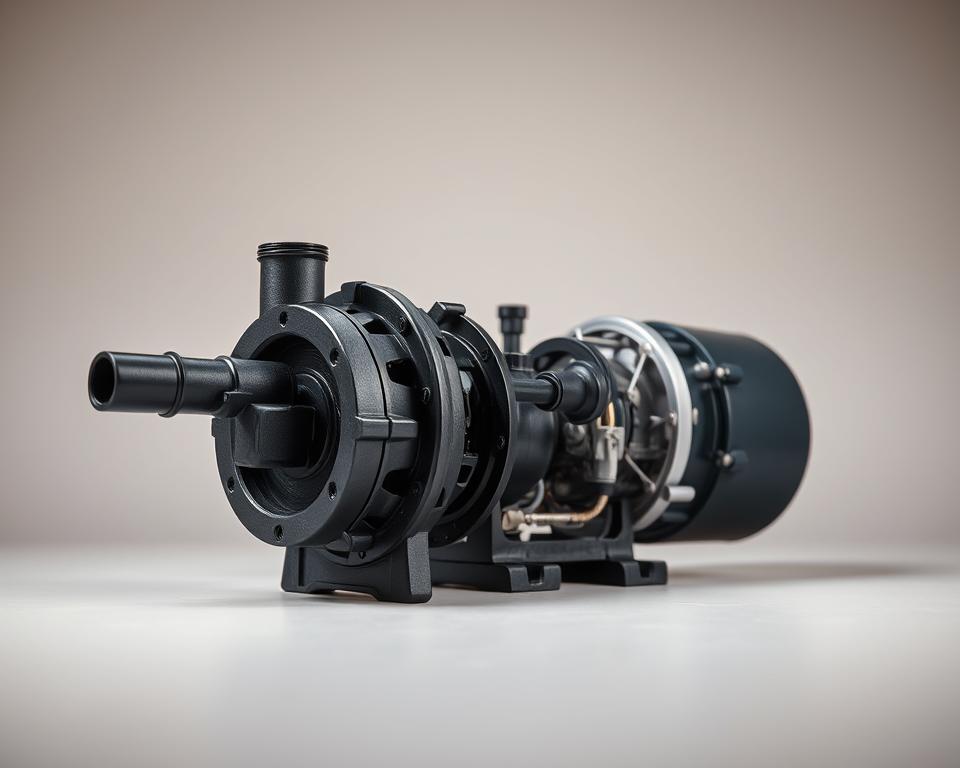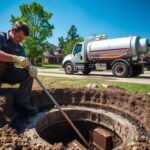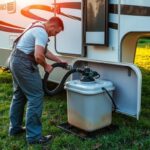RV Black Water Tank Pump Guide & Maintenance Tips
The RV black water tank pump plays a significant role in your RVing experience, have you considered its impact? This pump is a vital component of your RV’s plumbing for waste. Proper maintenance is crucial for seamless travels. You’ll find crucial information in this guide about managing your RV’s waste water pump. If you understand its importance, you can optimize its performance and have even better RV experiences.
Key Learnings
- For proper waste handling, the RV black water tank pump is essential.
- Regular maintenance can prolong the lifespan of your RV waste water pump.
- Knowing about the different parts of the system improves your ability to troubleshoot.
- For good hygiene and to protect the environment, safe dumping practices are vital.
- Winterizing your RV black water tank system can prevent costly repairs.
- Maintaining the cleanliness of your RV sanitation pump will help avoid clogs and unpleasant smells.
Knowing About Your RV’s Water Tanks
A lot of RV owners might not completely understand why different water tanks are important for easy camping with RV sewer pump. The functions of the RV fresh water, gray water, and black water tanks are important to be aware of. Each plays a unique role and needs proper care.
The RV fresh water tank is for storing drinkable water. It’s used for drinking, cooking, and hygiene. The most important thing is to ensure this tank is clean and the water is safe to use. Fresh water is crucial for hydration and health during travels.
In contrast, the RV gray water tank holds the water that has been used in sinks and showers. This tank can quickly become full, requiring frequent checks and draining. To keep your RV living area clean, it’s important to manage the gray water tank correctly.
This RV black water tank is crucial as it contains toilet waste. Regular attention is needed to prevent smells and the accumulation of waste in this tank. Applying the proper tank chemicals will improve the tank’s condition and your RVing experience. Knowing how to care for each tank makes RV trips more enjoyable.
RV Black Water Tank Pump: An Explanation
The RV black water tank pump is vital for recreational vehicle sanitation systems. Waste is transported by this pump to designated places for disposal. Understanding its operation is crucial for proper maintenance and preventing costly repairs.
Among the options for RV owners is the sewer pump, which is one type of pump. The macerator pump is a favorite because it grinds waste, making disposal faster. This is particularly useful when dump stations are crowded.
It’s vital to have a high-quality RV black tank pump for proper waste management. It ensures that the RV remains clean and comfortable for occupants. By regularly checking and knowing how your pump works, you can improve your RV experience.
Black Water Tank System Components: An Overview
For effective waste management, it’s vital to understand the RV black water tank system. For the system to function correctly, it relies on many essential components working together. Holding the waste from the RV’s toilet, the black water tank is the most important part. Designed to last through different conditions, it’s made of robust materials.

Playing a key role, the system’s pump transfers waste to a designated location for disposal. It’s a must-have for anyone with an RV. Sewer hoses also play a key part, offering a flexible connection between the tank and dump station. To ensure a clean disposal process, these hoses are made to stop leaks and keep smells inside.
Connection ports are vital for attaching sewer hoses, which helps in the effective transfer of waste. Controlling the flow of waste is the crucial role of termination valves. By preventing backflow and spills when disposing of waste, they help keep things sanitary.
Getting familiar with these essential components allows RV owners to maintain their sanitation system efficiently. This understanding is vital for solving problems during trips or when using the RV, enhancing the entire RV experience.
Best Practices for Using Your RV Black Water Tank Pump
Knowing how to use the RV sanitation pump well greatly improves your experience as an RV owner. Operating the black tank properly is crucial for ensuring the system works without issues. A crucial step is to make sure you flush the tank well after each use. This stops solid waste from building up, which can lead to clogs and other problems.
To make sure your RV sanitation pump is working correctly, perform regular checks. Taking this action beforehand can help you avoid any unpleasant occurrences while traveling. It is also essential to use toilet paper made specifically for RVs. Designed to disintegrate quickly, this type of toilet paper helps in reducing the risk of clogs.
Maintaining closed termination valves, except when emptying, is another crucial practice. It helps to stop odors from spreading. Also, adding tank deodorants and cleaners will help the system smell nice and stay clean. Adhering to these guidelines improves your experience with the RV black water tank.
| Correct Ways to Use Your Black Tank | Upsides |
|---|---|
| Flush with Plenty of Water | Prevents solid waste clogs |
| Routinely Check the Pump’s Operation | Ensures effective functioning |
| Use RV-Specific Toilet Paper | Lowers the chance of clogs |
| Keep Termination Valves Closed | Keeps smells to a minimum |
| Using Tank Deodorants and Cleaning Agents | Ensures the system remains hygienic and without odors |
Top Maintenance Tips for the Black Water Tank Pump
To ensure your RV’s black water tank pump lasts longer and works efficiently, it’s crucial to maintain it regularly. This means you need to use the correct chemical treatments that are designed for these types of tanks. These chemicals effectively break down waste and keep odors away.
Making sure there’s enough water when you use the toilet is also very important. Doing so helps waste move smoothly to the tank, minimizing buildup risk. In addition, it’s important to regularly deep clean the tank and all the parts that go with it. It’s important to use the tools that are recommended for this job.
Always monitor the tank levels to avoid any issues. Don’t wait to fix any leaks or overflows that you notice. Regularly emptying the tank is important to prevent the accumulation of solid waste. By setting up a maintenance schedule, you can help ensure a trouble-free experience with your RV.
| Job for Maintenance | Timing | Explanation |
|---|---|---|
| Look at levels | Each time you travel | To prevent leaks, ensure the tank is not filled too much. |
| Add chemical treatment | Following each emptying | Make sure to add treatments that will break down waste effectively. |
| Perform a system flush | Each month | Apply a cleaning solution to help keep the tank clean. |
| Look over the pump | Ahead of long trips | Inspect for any wear or damage so you don’t have breakdowns during your trip. |
| Drain the tank | As needed | When the tank is full, empty it, preferably at official dump stations. |
By adhering to these essential maintenance steps, you can ensure your black water tank pump works well. This will improve your RV trips significantly.
Dealing with Common Black Water Tank Pump Issues
Dealing with problems with your black tank pump might seem difficult. A lot of RV owners experience different problems with their RV black tanks, like clogs, leaks, or smells that won’t go away. Learning how to handle these problems when they first appear can save you time and prevent costly repairs.
First, you should inspect the hoses that are connected to the black tank pump. Often, blockages form in these hoses, making the pump less effective. Detach the hoses and check them for any accumulation or foreign matter. If you discover any blockages, ensure the hoses are completely clean before you put them back.
Then, you should assess the seals that are located around the pump and the tank. Leaks can be caused by damaged seals, and these leaks might not be noticed until they’ve caused significant damage. If you find any seals that are not working properly, replace them right away to stop more problems from happening.
Using enzyme treatments can be beneficial for odors that persist. These treatments help to break down the waste and lessen the unpleasant smells. To get the best results, be sure to follow the instructions that came with the product.
Here is a quick reference table summarizing common issues and their solutions:
| Concern | Potential Reason | What to Do |
|---|---|---|
| Obstructions | Waste material in the hoses or tank | Make sure to check and clean the hoses |
| Leaks | Seals that have been damaged | Make sure to inspect the seals and replace any that are damaged |
| Stinky smells | Waste that has accumulated | Try using enzyme treatments |
| Pump is out of order | Issues with the wiring | Check connections and battery |
Recognizing the warning signs early on can prevent minor issues from turning into major problems with your RV black tank. Regular upkeep and careful attention will help your black tank pump last longer, which will make better your time in your RV.
How to Clean Your RV Black Water Tank Pump
Maintaining a clean RV black water tank is crucial for both hygiene and the proper operation of its plumbing system. Make it a goal to rinse with fresh water after each use to minimize odors and ensure smooth operation. This reduces waste buildup and maintains the tank’s condition.
If you need a more intensive clean, use cleaning solutions that are formulated for black water systems. They work well to break down waste and get rid of odors. Add water and the cleaning solution to the tank, and then let it soak. The job of cleaning is made easier if your RV has a built-in flush system.
Driving with sharp turns or using sloshing techniques can help to stir up the contents of the tank. It assists in loosening any residue that may be clinging to the inside of the tank. Such cleaning methods improve sensor accuracy, avoiding sewage-related problems.
Best Practices for Safe RV Waste Dumping
It’s important to learn the correct procedures at RV dump stations to keep them in good condition for everyone. Once you arrive at a station, ensure your RV is positioned properly. Then, get your gear ready for dumping.
For a smooth process, make sure to follow these steps closely:
- Check that your sewer hose is tightly connected to the station’s outlet.
- Begin by opening the valve for the black water so the sewage can come out.
- Once the black tank is completely empty, close its valve. Then, open the gray water valve to clean the hose with the less dirty water.
- When you’re done, carefully take off your hose to avoid any spills.
- Always use safe drinking water to clean your hoses and then store them immediately.
It’s also vital that you adhere to the local laws regarding waste disposal. Many places have rules you must obey to protect the environment. Failure to follow these regulations can lead to fines or other problems.
It’s important to be respectful at RV dump stations so that everyone has a better experience. When you keep the area clean and follow the rules, it shows you care about the community. These kinds of actions help to build a culture of responsibility among RV lovers and encourage camping habits that are environmentally friendly.
How to Winterize Your RV Black Water Tank System
It’s crucial to winterize your RV tanks to prevent the black water system from freezing and getting damaged. You need to prepare properly to avoid damage that can be caused by frozen water in the system. Following specific steps ensures effective winter care of the RV black tank.
- First, make sure to completely drain the black water tank using the appropriate pump and connections.
- Following that, bypass the water heater to stop water from getting in and building up in the unit.
- Use RV-specific antifreeze, as regular antifreeze can be toxic and harmful to the environment. Pour the antifreeze into the system according to the product instructions.
- Leave all faucets and drains open to allow any remaining water to escape and for the antifreeze to circulate properly.
- Finally, ensure that all access panels are properly sealed and secured to prevent water from entering during the winter.
Following these winterization steps allows RV owners to protect their black water tank systems from the severe impacts of winter. This proactive approach helps to avoid expensive repairs or maintenance when the seasons change.
Wrapping It Up
To be a successful RV owner, you really need to maintain your RV black water tank efficiently. Learning how to use the black water tank pump properly and following the maintenance advice in this guide will make your trips more enjoyable. If you take proper care of your gear, it will last longer and managing RV waste will be simpler. This makes travel less daunting.
Knowing about your RV’s black water system is essential for dealing with problems directly. Following good maintenance, troubleshooting, and cleaning procedures will help prevent unexpected malfunctions. This lets you enjoy worry-free road trips. Using well-regarded services like All in Sanitation can strengthen your maintenance efforts. They provide the key products and support needed for excellent maintenance.
Attentiveness and proper care for every part of your RV, including the black water tank, are part of being a good RV owner. Having this information means you’re now ready to explore without any concerns. You’ve taken all the right steps to make sure you and others have an excellent journey.

